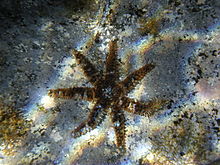- Coscinasterias tenuispina
-
Coscinasterias tenuispina 
Scientific classification Kingdom: Animalia Phylum: Echinodermata Subphylum: Eleutherozoa Class: Asteroidea Order: Forcipulatida Family: Asteriidae Genus: Coscinasterias Species: C. tenuispina Binomial name Coscinasterias tenuispina
(Lamarck, 1816) [1]Synonyms[1] - Asteracanthion tenuispinum Müller & Troschel, 1842
- Asterias atlantica Verrill, 1868
- Asterias glacialis Grube, 1840
- Asterias savaresi Delle Chiaje, 1825
- Asterias tenuispina Lamarck, 1816
- Coscinasterias (Stolasterias) tenuispina (Lamarck, 1816)
- Coscinasterias (Stolasterias) tenuispina (Sladen, 1889)
- Lytaster inaequalis Perrier, 1894
- Polyasterias tenuispina Perrier, 1894
- Stellonia tenuispina d'Orbigny, 1839
Coscinasterias tenuispina is a starfish in the family Asteriidae. It is sometimes called the blue spiny starfish or the white starfish. It occurs in shallow waters in the Atlantic Ocean and the Mediterranean Sea.[1]
Contents
Description
Coscinasterias tenuispina has from 6 to 12 arms (usually 7), often of varying lengths, and grows to 20cm (8in) in diameter. It is a creamy, slightly bluish colour, variously blotched with brown, and is rough textured with short spines.[2]
Distribution
The range of Coscinasterias tenuispina includes the Mediterranean Sea, France, Spain and Portugal, the Azores and other Atlantic Islands, Bermuda, Cuba and the American coast between North Carolina and Santos, Brazil. It is found on the lower shore and down to a depth of about 50m (160ft).[1] A number of divergent populations of the starfish in the Atlantic and Mediterranean are believed to be deserving of being recognized as sub-species. The female population of the starfish in the Mediterranean is larger than that of the males.[3]
Biology
Coscinasterias tenuispina is a predator and an omnivore. The starfish is found on hard bottoms and under stones and seaweed where it mainly feeds on other echinoderms and on bivalve molluscs.[3] In most of its range, it undergoes sexual reproduction in the winter, while in the summer, it proliferates by asexual reproduction.[4] To begin the process of asexual reproduction, or "fission", the disc tears itself into two sections, with each part eventually growing extra arms and developing into a new individual.[4] In Brazil, all individuals seem to be male and fission occurs throughout the year.[5]
References
- ^ a b c d Coscinasterias tenuispina (Lamarck, 1816) World Asteroidea Database. Retrieved 2011-09-28.
- ^ Marine Species: Coscinasterias tenuispina Skaphandrus.com. Retrieved 2011-09-28.
- ^ a b Blue spiny starfish: Coscinasterias tenuispina Archipelagos Wildlife Library. Retrieved 2011-09-28.
- ^ a b Crozier, W. J. (1920). "Notes on some problems of adaptation, 2. On the temporal relations of asexual propagation and gametic reproduction in Coscinasterias tenuispina; with a note on the direction of progression and the significance of the madreporites.". Biol. Bull. 39 (2): 116–29.
- ^ Alves, L. S. S., A. Pereira and C. Ventura (2001). "Sexual and asexual reproduction of Coscinasterias tenuispina (Echinodermata: Asteroidea) from Rio de Janeiro, Brazil". Marine Biology 140 (1): 95–101. doi:10.1007/s002270100663. http://www.springerlink.com/content/51prw0b14v0jfgt8/.
Categories:- Asteroidea
- Animals described in 1816
Wikimedia Foundation. 2010.
